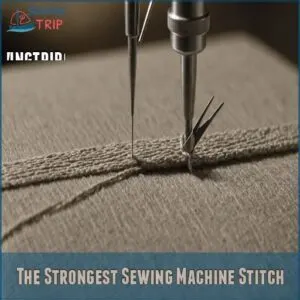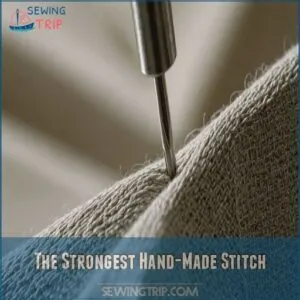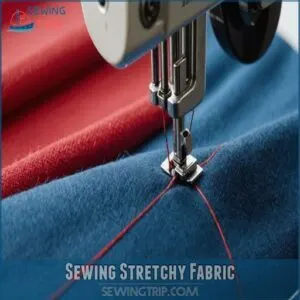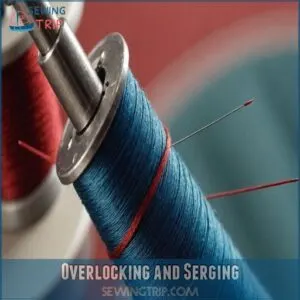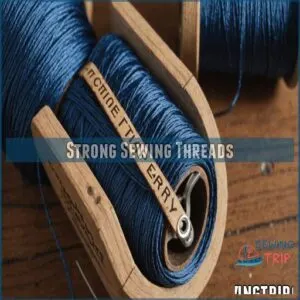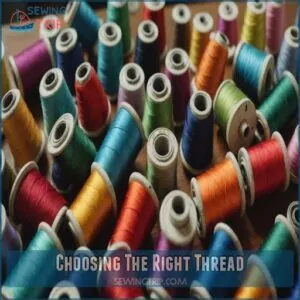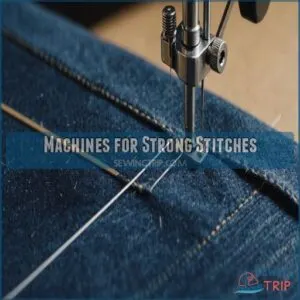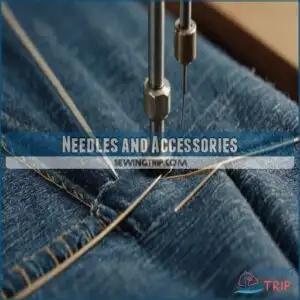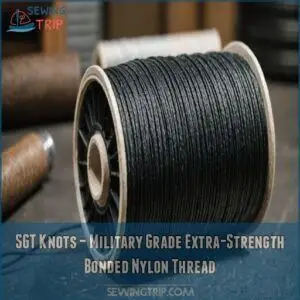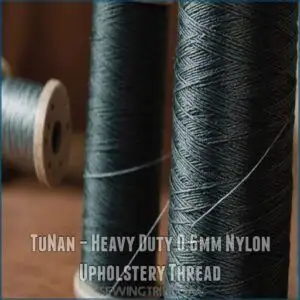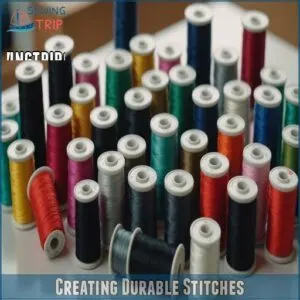This site is supported by our readers. We may earn a commission, at no cost to you, if you purchase through links.
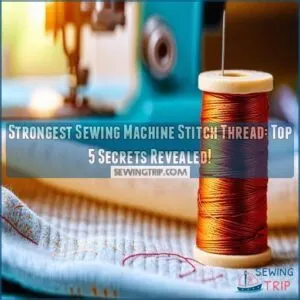
The straight stitch, paired with nylon or polyester thread, offers unbeatable durability.
It’s like the superhero of stitches – simple yet mighty!
You’ll find this combo can withstand the tugs and pulls of everyday wear, making it perfect for heavy-duty projects.
But don’t get stuck in a straight line; sometimes, a zigzag stitch is your secret weapon for stretchy fabrics.
Remember, the right thread thickness matters too.
Upholstery nylon might be your new best friend for those extra tough jobs.
And here’s a little teaser: there’s more to thread strength than meets the eye.
Table Of Contents
- Key Takeaways
- The Strongest Sewing Machine Stitch
- The Strongest Hand-Made Stitch
- Sewing Stretchy Fabric
- Overlocking and Serging
- Strong Sewing Threads
- Choosing The Right Thread
- Machines for Strong Stitches
- Needles and Accessories
- Thread Recommendations
- Creating Durable Stitches
- Frequently Asked Questions (FAQs)
- Conclusion
Key Takeaways
- The straight stitch is your go-to for strength, especially when paired with nylon or polyester thread. It’s simple yet mighty, perfect for most heavy-duty projects.
- For stretchy fabrics, you’ll want to use a zigzag or triple zigzag stitch. These allow the fabric to stretch without breaking the threads.
- Upholstery nylon is the strongest thread option, thanks to its resin coating and high tensile strength. It’s ideal for heavy fabrics and outdoor projects.
- Your sewing machine matters. Look for features like a heavy-duty motor, strong needle plate, and adjustable pressure foot when tackling tough materials.
The Strongest Sewing Machine Stitch
When it comes to the strongest stitches, understanding the role of thread type is key, and learning how strong is sewing can make all the difference. You might be surprised to learn that the strongest sewing machine stitch is actually the simplest: the straight stitch.
This workhorse of the sewing world creates multiple layers of thread on top of each other, making it tough to tear and perfect for joining fabrics securely.
Uses of The Straight Stitch
With a straight stitch, you’ll be sewing seams like a pro in no time.
It’s your go-to for fabric joining, mending tears, and basic garment construction.
You can use it for quilting projects, creating durable seams that’ll stand the test of time.
Whether you’re working with nylon thread or polyester thread, the straight stitch’s tensile strength is hard to beat.
It’s the backbone of your sewing arsenal, perfect for everything from hemming pants to crafting intricate quilt designs.
Benefits of The Straight Stitch
The straight stitch is your sewing Swiss Army knife.
You’ll love its durability, creating seams tough as nails.
It’s versatile too, perfect for most fabrics and projects.
Ease of use? It’s a breeze, even for beginners.
You’ll get a clean finish every time, giving your work that pro look.
Plus, it’s compatible with virtually every sewing machine out there.
Talk about a stitch that’s got your back!
Making a Straight Stitch Even Stronger
You’ve mastered the straight stitch, but let’s kick it up a notch.
Boost your stitch density by shortening the stitch length, especially for woven materials where a straight stitch produces a more robust bond.
Make multiple passes over the same line for added strength.
Adjust your thread tension and needle size to match your fabric type, as seam strength factors like stitch length and tension also
The Strongest Hand-Made Stitch
You might think hand-stitching can’t compare to machine strength, but you’d be wrong.
The backstitch, a simple yet powerful hand-sewn technique, rivals machine stitches in durability.
It can be made even stronger by using thicker threads like bonded 3-ply nylon.
Advantages of The Hand-Made Backstitch
Mastering the backstitch opens a world of DIY repairs and durable handsewn creations.
This versatile stitch outshines machine stitches in many scenarios, especially when used to create a strong and uniform seam.
Here’s why it’s your go-to for strength:
- Unmatched durability for high-stress areas
- Simplicity makes it perfect for on-the-go fixes
- Versatility across various
Using Thicker Threads for Hand-Sewn Stitches
Thicker threads can be your secret weapon for creating the strongest hand-sewn stitches.
When you’re tackling heavy-duty projects, opt for bonded 3-ply nylon thread.
It’s a game-changer for durability.
Remember, increasing stitch length uses more thread, making your stitches even stronger.
Here’s a quick guide to thread types and their best uses:
| Thread Type | Best For |
|---|---|
| Upholstery Nylon | Heavy fabrics, outdoor gear |
| Polyester | Stretchy materials, everyday use |
| Cotton | Natural fibers, delicate fabrics |
| Silk | Fine details, lightweight fabrics |
Sewing Stretchy Fabric
You’ll need to switch gears when sewing stretchy fabric, as your trusty straight stitch won’t cut it here.
Instead, opt for a zigzag or triple zigzag stitch, which allows the fabric to stretch without snapping those threads you’ve so carefully placed.
Limitations of The Straight Stitch for Stretchy Fabric
Straight stitches and stretchy fabric are like oil and water – they just don’t mix well.
When you’re sewing stretchy fabric, a straight stitch can lead to several issues:
- Puckering: The fabric bunches up, creating unsightly ridges
- Fabric distortion: Your garment loses its intended shape
- Seam splitting typically occurs when sewing stretch fabrics without a suitable stitch, such as the best stitch for stretch fabric. Stitches break when the fabric stretches
- Stitch durability: The straight stitch lacks stretch resistance
Don’t let these limitations tie you down. There’s a whole world of stitches designed to dance with your stretchy fabrics!
Benefits of The Zig-Zag Stitch for Stretchy Fabric
Why struggle with tight seams when you can embrace the zigzag stitch?
This versatile stitch is your secret weapon for sewing stretchy fabric.
It allows for fabric movement, preventing those pesky puckers and tears.
You’ll love how it distributes strain evenly, giving your seams flexibility and strength.
Say goodbye to popped stitches and hello to comfortable, long-lasting garments.
It’s like giving your fabric room to breathe and dance!
Using Triple Zig-Zag Stitch for Elastic Materials
When you’re tackling super stretchy fabrics, the triple zig-zag stitch is your secret weapon.
It’s like giving your seams superpowers.
This stitch, also known as the tricot stitch, offers unbeatable strength and flexibility.
For even better results, consider pairing it with a ballpoint needle, which is recommended for knit fabrics like jersey and lycra materials.
Here’s why it’s a
Overlocking and Serging
You’ll love overlocking, a technique that creates strong, professional-looking seams by knitting threads over fabric edges.
Whether you’re using a specialized serger or your regular sewing machine with the right settings, overlocking will give your projects that polished, ready-to-wear finish you’ve always wanted.
Benefits of Overlocking for Seam Edges
With overlocking, you’re giving your seams superpowers.
This technique wraps thread around fabric edges, preventing fraying and boosting durability.
You’ll love the professional finish it creates, making your projects look store-bought.
Overlocking isn’t just about looks; it adds serious strength to your seams, thanks to the serger’s multi-thread capabilities.
It’s like giving your fabric
Using a Serger or Overlocking Machine
Ready to take your seam game up a notch?
Let’s talk sergers and overlockers.
These powerhouse machines are like the Swiss Army knives of sewing, giving you professional-looking edges in a snap.
When working with a serger or overlocker, you need to choose the right thread from top overlock thread brands for smooth seams.
Here’s what you
Achieving Overlocking With a Regular Sewing Machine
Don’t have a serger? No problem! You can still achieve professional-looking overlocked edges with your regular sewing machine. It’s like teaching an old dog new tricks. Just grab an overlock foot attachment and adjust your settings. Here’s a quick guide to get you started:
| Stitch Type | Machine Setting | Best For |
|---|---|---|
| Zigzag | Width: 5, Length: 2 | Light fabrics |
| Overcasting | Specific overcast stitch | Medium fabrics |
| Triple Zigzag | Width: 5, Length: 1 | Heavy fabrics |
| Mock Overlock | Overlock stitch setting | Knits |
| Rolled Hem | Rolled hem foot | Delicate fabrics |
Strong Sewing Threads
You’ll find upholstery nylon at the top of the thread strength chart, thanks to its unique resin coating and high tensile strength.
Upholstery nylon is a great choice for stitching heavy fabrics or tackling outdoor projects.
Choosing the right thread can make or break your sewing success.
Upholstery Nylon as The Strongest Thread
Overlocking’s great, but let’s talk thread strength.
Upholstery nylon takes the cake as the toughest thread in town.
You’ll find it’s a game-changer for your heavy-duty projects, especially when paired with a specialized upholstery machine.
Here’s why it’s the heavyweight champ:
- Coated with special resin for extra oomph
- Resists splitting
Benefits of Nylon Thread
Nylon thread’s not just tough—it’s your sewing superpower.
You’ll love its incredible durability and strength, perfect for those heavy-duty projects that’d make other threads snap.
It’s like giving your stitches a suit of armor!
Plus, nylon’s elasticity lets your seams flex without breaking.
For outdoor gear, UV-resistant nylon’s got your back, laughing in the face of sun damage.
It’s a bit pricier, but for unbeatable tensile strength, it’s worth every penny.
Other Strong Thread Options
While upholstery nylon reigns supreme, you’ve got a thread arsenal at your fingertips.
Polyester thread, the jack-of-all-trades, offers strength and versatility.
Cotton thread, nature’s workhorse, excels in high-heat situations.
For a touch of luxury, silk thread brings strength and sheen.
Linen thread stands up to heavy-duty tasks, while metallic thread adds sparkle without sacrificing durability.
When working with various sewing machine stitches, such as the versatile blind hem stitch for professional finishes, mix and match these options to create the strongest sewing machine stitch for your unique project.
Choosing The Right Thread
You’ll need to keep in mind several factors when selecting the right thread for your sewing project, including the fabric type, stitch strength required, and intended use of the finished item.
From lightweight cotton to heavy-duty nylon, each thread type has its own strengths and ideal applications, so choosing wisely can mean the difference between a sturdy seam and a frustrating unraveling mishap.
Factors to Consider for Thread Selection
Now that you’re armed with knowledge about strong threads, let’s unravel the mystery of choosing the right one for your project.
It’s not just about picking the toughest thread on the shelf.
You’ve got to keep in mind several factors to make sure your stitches hold up under pressure.
For instance, if you’re working with heavy fabrics, you’ll want to choose a thread that’s specifically designed for heavy fabric sewing.
Here’s what you need to keep in mind:
- Fabric type
- Project weight
- Stitch type
- Thread thickness
Thread Types for Specific Sewing Tasks
Picking the right thread is like choosing the perfect dance partner for your fabric.
For leather, you’ll want heavy-duty nylon thread that can handle the tango.
Denim craves strong polyester or cotton threads that won’t break under pressure.
Silk demands a delicate touch with fine, smooth threads.
Upholstery? Go for the strongest thread you can find, like upholstery nylon.
And for quilting, cotton thread is your trusty sidekick.
Machines for Strong Stitches
You’ll need a robust sewing machine to create the strongest stitches, and not all machines are up to the task.
When choosing a sewing machine for heavy-duty work, consider the type of sewing you’ll be doing, whether it’s garment sewing or repairs, and note that hand sewing vs machine for delicate fabrics. Let’s explore the key features that make a sewing machine capable of handling heavy-duty work and introduce some top-performing models that won’t let you down when you’re tackling tough fabrics.
Features to Look for in a Heavy-Duty Sewing Machine
A powerhouse sewing machine is your ticket to tackling tough fabrics.
Look for a heavy-duty motor that won’t break a sweat, paired with a strong needle plate and durable feed dog to handle thick materials.
You’ll want stitch length control and an adjustable pressure foot for versatility.
Don’t forget about heavy-duty sewing needles and an overlocking foot for those professional finishes.
With these features, you’ll be stitching up a storm in no time!
Recommended Sewing Machines for Strong Stitches
You’ve got the features down, but let’s talk machines that deliver.
For heavy-duty work, the Singer 4423 is a workhorse.
It’ll power through leather like butter.
On a budget?
The Brother ST371HD won’t break the bank but still packs a punch.
For industrial-strength stitches, the Juki DDL-8700 is your go-to.
Remember, the right machine paired with upholstery nylon thread will have you stitching up a storm in no time!
Needles and Accessories
You’ll need the right tools to create the strongest stitches, and that starts with choosing the proper needles and accessories.
From heavy-duty needles that can punch through thick fabrics to specialized feet like the overlocking foot, these companions to your thread choice can make or break your sewing project’s durability.
Selecting The Right Needles for Heavy Materials
Let’s talk needles for those tough fabrics.
The right needle can make or break your heavy-duty sewing project.
Remember, bigger isn’t always better – it’s about matching the needle to your material.
Here’s a quick guide to help you thread the needle on this topic:
- Needle size 90/14 for medium-weight fabrics
- Needle size 100/16 for heavy denim or canvas
- Needle size 110/18 for extra-thick upholstery
- Titanium-coated needles for longer-lasting sharpness
Choose wisely, and you’ll be stitching through leather like it’s butter!
Overlocking Foot and Other Helpful Accessories
Once you’ve got the right needles, it’s time to gear up with accessories.
The overlocking foot is your secret weapon for pro-level edges.
It’s like having a mini-serger right on your machine!
Pair it with heavy-duty thread, and you’ll be unstoppable.
Don’t forget other handy tools like a walking foot for thick fabrics or a buttonhole foot for perfect closures.
These accessories will take your sewing game to the next level.
Thread Recommendations
You’ll want to choose your thread wisely for strong, lasting stitches.
We’ve tested two top contenders: SGT Knots’ Military Grade Extra-Strength Bonded Nylon Thread and TuNan’s Heavy Duty 0.6mm Nylon Upholstery Thread.
SGT Knots – Military Grade Extra-Strength Bonded Nylon Thread
Now that you’ve got the right needles, it’s time to pair them with a thread that can handle anything.
Enter SGT Knots’ Military Grade Extra-Strength Bonded Nylon Thread, available in various products at the SGT Knots thread store.
This beast of a thread isn’t playing around.
It’s like the Navy SEAL of threads –
TuNan – Heavy Duty 0.6mm Nylon Upholstery Thread
TuNan’s Heavy Duty 0.6mm Nylon Upholstery Thread is a game-changer for your toughest projects.
This powerhouse thread tackles leather stitching and upholstery work like a pro.
Its durable nylon composition stands up to wear and tear, making it the strongest thread for upholstery you’ll find.
Compatible with most sewing machines, it’s your go-to for heavy-duty tasks.
You’ll feel like a DIY superhero, conquering even the most challenging materials with ease.
Creating Durable Stitches
You’ll find creating durable stitches isn’t rocket science, but it does require attention to detail.
By selecting the right thread, adjusting your machine properly, and using the appropriate stitch type for your fabric, you’ll be crafting seams that can withstand the test of time (and the occasional tug-of-war with your dog).
Tips for Achieving Strong Stitches
To create stitches that can withstand the test of time, you’ll need to master a few key techniques.
Start by selecting the right thread quality and needle size for your fabric type.
Adjust your stitch tension carefully – it’s the secret sauce for strong seams.
Don’t skimp on seam finishing; it’s like giving your stitches a suit of armor.
To achieve the perfect balance, it’s also crucial to troubleshoot issues like why my sewing machine sew zig zags that can weaken your stitches. Remember, the strongest sewing machine stitches come from a perfect balance of all these factors.
With practice, you’ll be stitching up storm-proof seams in no time!
Troubleshooting Common Stitching Issues
You’ve mastered strong stitches, but hiccups happen. Skipped stitches? Check your needle’s not bent or dull.
Uneven tension got you in a twist? Balance your upper and lower thread tension.
Fabric puckering like a disappointed grandma? Lighten up on that presser foot pressure.
Thread breaking faster than New Year’s resolutions? Use the right weight for your fabric.
With these tricks up your sleeve, you’ll be stitching like a pro in no time!
Frequently Asked Questions (FAQs)
What is the strongest stitch on a sewing machine?
The straight stitch reigns supreme on your sewing machine.
It’s a tough cookie, layering threads for maximum durability.
You’ll find it as the first option on most machines.
For extra strength, secure those seam ends with back-and-forth stitching.
What is the strongest stitch?
Sew, you’re looking for the iron-clad champion of stitches?
Straight stitch reigns supreme on machines, threading layers for unbeatable durability.
It’s your go-to for tough jobs, but remember, zigzag‘s your stretchy fabric savior.
Master these, and you’ll conquer any sewing challenge.
What is the strongest sewing thread?
Upholstery nylon reigns supreme as the strongest sewing thread.
Its unique resin coating boosts durability, preventing splits and tears.
You’ll find this thread’s high tensile strength perfect for heavy-duty projects, from leather work to outdoor applications.
What type of stitch should I use with a sewing machine?
For most projects, you’ll want to use a straight stitch.
It’s your go-to workhorse, offering strength and simplicity.
When sewing stretchy fabrics, switch to a zigzag stitch to allow for movement.
Experiment with different stitches for unique projects.
What is the strongest handsewn stitch?
A stitch in time saves nine," they say, and the backstitch proves it!
You’ll find this handy technique’s your best bet for hand-sewing strength.
It loops through fabric, creating a durable seam that’ll withstand wear and tear like a champ.
What is a straight stitch on a sewing machine?
You’ll find the straight stitch as the first option on most sewing machines.
It’s a simple, strong stitch that creates a line of evenly spaced stitches.
It’s your go-to for joining fabric pieces securely.
How often should I replace my sewing machine needle?
Replace your sewing machine needle every 8-10 hours of sewing time or after completing a project.
If you’re tackling tough fabrics or hear a popping sound, it’s time for a new needle.
Regular changes guarantee clean, precise stitches.
Can I use dental floss for sewing emergencies?
Like a lifeline in a storm, dental floss can be your sewing savior in emergencies.
It’s strong and can hold things together temporarily, but it’s not ideal for permanent fixes.
Use it sparingly when you’re in a pinch.
Whats the best stitch for sewing leather?
For leather, opt for a strong straight stitch.
Use a longer stitch length to prevent weakening the material.
Pair it with a sturdy needle and heavy-duty thread.
If your machine allows, a walking foot can help feed thick leather evenly.
How do I prevent thread from tangling while sewing?
Thread tangling can be a sewing nightmare, but you’ve got this!
Make sure you have proper tension, use quality thread, and clean your machine regularly.
Thread your machine correctly, hold both threads when starting, and maintain a steady pace while sewing.
You’ll be stitching smoothly in no time!
Are natural or synthetic threads stronger for embroidery?
Synthetic threads typically outperform natural ones for embroidery strength.
You’ll find polyester and nylon offer superior durability and colorfastness.
However, natural threads like cotton and silk have their place, providing unique textures and a classic look to your designs.
Conclusion
Picture your sewing projects as armor, ready to face life’s battles.
By mastering the strongest sewing machine stitch thread techniques, you’re equipping yourself with an unbeatable arsenal.
Remember, the straight stitch is your trusty sword, while zigzag becomes your shield against stretchy foes.
Choose your thread wisely – it’s the lifeblood of your creations.
With these secrets in your toolkit, you’re set to conquer any sewing challenge.
So thread that needle, fire up your machine, and let your stitches stand the test of time!
- https://www.sciencedirect.com/topics/engineering/tensile-strength
- https://airborne-sys.com/wp-content/uploads/2016/09/Implementation-of-Modeling-and-Simulation-of-Textile-Seam-and-Joints-for-Parachute-Design-Applications.pdf
- https://www.definitions.net/definition/specific+strength
- https://www.singer.com.tr/en/corporate/history
- https://www.independent.co.uk/extras/indybest/house-garden/household-appliances/best-sewing-machines-for-beginners-quilting-kids-curtains-leather-a9069201.html

